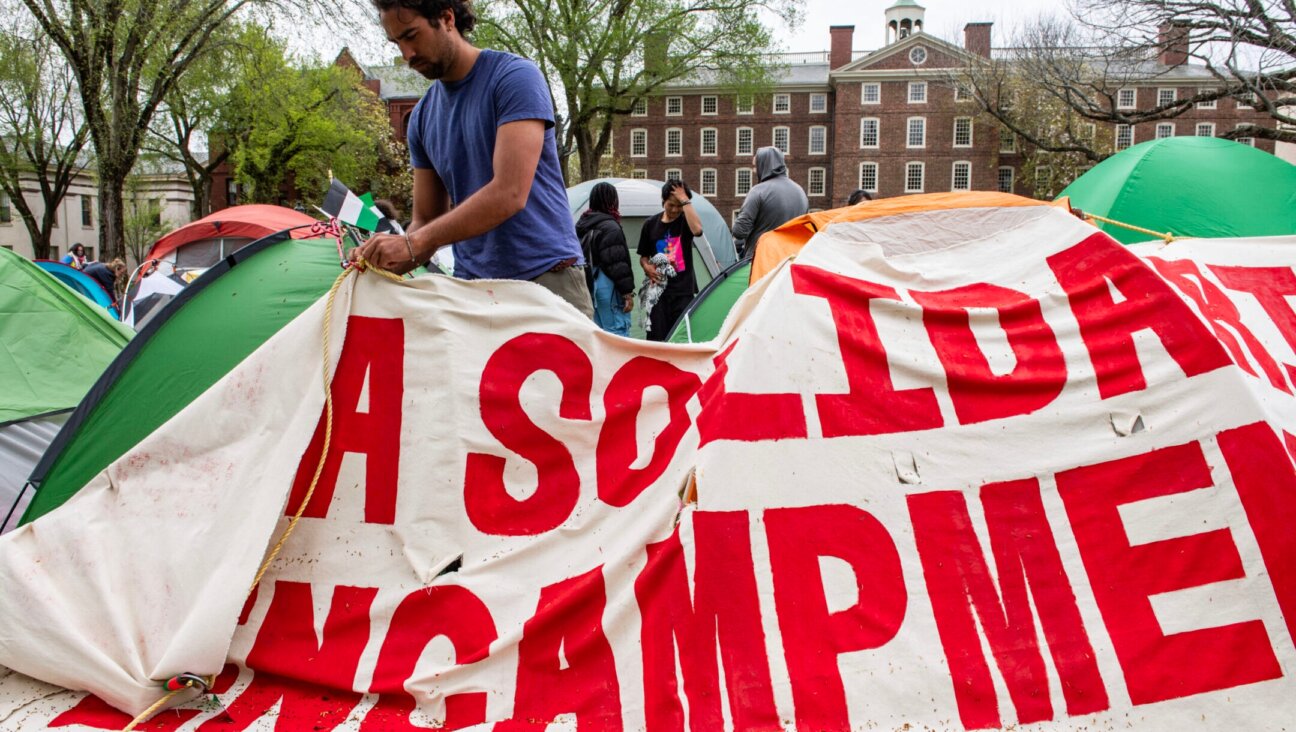Jerry Nadler Voted In Favor of Iran Deal — and Will Survive To Tell

Image by Claudio Papapietro
The last time Jerry Nadler faced a serious threat to his congressional seat, Bill Clinton had never met Monica Lewinsky, Newt Gingrich had not yet been voted speaker of the House, Kurt Cobain had just died and Justin Bieber had just been born.
But now, after more than two decades as the largely-uncontested representative-for-life of a congressional district stretching from Manhattan’s West Side to Brooklyn’s Boro Park, one of the most powerful Jews in New York City politics appears to face a political fight on the horizon.
Nadler represents an estimated 270,000 Jewish New Yorkers in Congress, according to estimates revised last year by the Berman Jewish DataBank — 100,000 more Jews than anyone else in the House. Thus, his decision in late August to support the framework agreement for a nuclear deal with Iran was an acute blow to the swath of Jewish communal heavy-hitters battling against the deal, including the American Israel Public Affairs Committee and the American Jewish Committee — not to mention the Israeli government.
Nadler bucked them all. And some opponents have lashed out.
An anonymous advertisement in the September 3 issue of the Flatbush Jewish Journal, an Orthodox newspaper, splashed the headline “How do you spell betrayal? N-A-D-L-E-R.” Dov Hikind, an ultra-hawkish member of the New York State Assembly whose district overlaps with Nadler’s in Brooklyn, parked a red double-decker tour bus outside Nadler’s Manhattan office with a photograph of a smiling Iranian Supreme Leader Ayatollah Ali Khamenei on the side. (Hikind declined a request for an interview or further comment on Nadler or his protest against Nadler for this story.)
Weeks later, with the fight over the deal fading into that infinite archive of half-forgotten communal spats, Nadler’s allies have resigned themselves to the likelihood that some segment of the burned opponents of the deal will put up a primary challenger when he runs for re-election in 2016. And while even potential backers of a challenger agree that Nadler is unbeatable, the coming campaign for Congress’s most Jewish seat could turn into a messy fight, one that exposes the challenges faced by liberal Jewish leaders holding on to positions of power in the face of an ascendant Jewish right.
•
Jerry Nadler is a nerd. You can see it in the massive glasses masking his face in an old picture from his days in the New York State Assembly, and in the dark suit that makes him look like someone’s dad in the 1969 New York Times photo of him with a group of floppy-haired 20-something Democratic activists.
Mostly, though, you can hear it in the way he talks about Congress. A math and science guy in a Congress full of social science and humanities majors, Nadler edited his high school science magazine and dreamed of a career that involved astrophysics. Instead, he’s devoted all that nerdish focus to politics, sneaking in some science books and science fiction novels in his spare time. (He’s currently reading a book called “Life Ascending: The Ten Great Inventions of Evolution” by a biochemistry professor at University College London named Nick Lane. “Why do we have sex? What is the advantage?” Nadler asked, paraphrasing the book’s general thrust. “All higher life forms have sex. Why? Why don’t we reproduce like cloning in a plant? Very interesting question.”)
New York State Assemblyman Richard Gottfried, a friend since high school, tells a story about a dull day in Albany when Nadler was still in the Assembly. Everyone was doodling to make it through some meeting, and when Gottfried looked down at Nadler’s paper, he saw it full of little boxes. Gottfried asked what Nadler had drawn. “Oh, this is a map of the election districts in my assembly district,” Nadler told him. (A version of the story recounted in the magazine City & State in 2010 is slightly different: Nadler, Gottfried was reported saying at the time, was filling in a chart with turnout figures for each of his election districts.)
In an interview at his office in a dreary federal building in downtown Manhattan in early October, Nadler grew most animated while explaining the picayune details of how he and a bipartisan group of three other members of the House Judiciary Committee had been able to push the USA Freedom Act through the House and the Senate in May and June, a bill that preserved many post-9/11 provisions of the USA Patriot Act while placing limits on the National Security Agency’s bulk collection programs, among other changes.
Nadler is similarly precise when describing his thought process on the Iran vote. He says that his decision came down to a question about the validity of a single argument made to him by Israeli Ambassador Ron Dermer and by AIPAC’s representatives: that if Congress were to reject the deal, the United States could maintain international sanctions against Iran and negotiate for a better deal by threatening other countries with trade bans if they lifted their own sanctions.
“I said to the president, when I met with him, that he had to meet this argument head-on, because it was a plausible argument and I didn’t know if it was right or wrong,” Nadler said.
After reading the administration’s answer, in the form of an August 13 op-ed in The New York Times by Treasury Secretary Jack Lew, and talking to experts, Nadler said that three points satisfied him that Dermer and AIPAC’s argument didn’t make sense: Imposing the trade bans would be disastrous for America’s economy. Other countries, such as Germany, wouldn’t believe that the United States would actually impose trade bans on them. And since the administration opposes the whole notion, they wouldn’t have done it anyhow. So he voted in favor of the deal.
“Now, obviously, people are very angry,” Nadler said. “Some people are very happy, but a lot of people are very angry, and they’re threatening a primary fight, and maybe there will be one, and if so, we’ll be prepared for it. We’ll handle it. I’ve done a lot of work in this district. People know me.”
•
If the Upper West Side is a shtetl, as corny glad-handers like to say when you run into them on West End Avenue on a Saturday, then the Fairway Market on 74th and Broadway is its village square, except with sawdust on the ground instead of cow manure. On the sidewalk outside that Fairway in early October, Jerry Nadler had no shortage of fans.
“I think he reflects the values of New York in general, and the Upper West Side in particular,” said Robert Stinerock, a college professor who attended Columbia University at the same time as Nadler and has lived in the neighborhood, on and off, ever since. Stinerock called Nadler’s vote in support of the Iran nuclear deal “gutsy.”
Asked about the possibility of a serious primary challenge in response to Nadler’s Iran vote, Ken Bronfenbrenner, another longtime Upper West Side resident heading into Fairway for a midmorning shop, was resolute. “Then I’ll send him some money,” he said.
That Nadler has goodwill here is no surprise. Though brought up in Lakewood, New Jersey, and in Brooklyn, Nadler has been playing politics on the Upper West Side since the late 1960s. The Upper West Side is the base of his empire, and the source of his muscle. In New York City politics, the Upper West Side is known as a goldmine for votes, a neighborhood where turnout on Election Day and Democratic primary day is higher than anywhere else in the city. Someone who can move those votes is a powerful friend in the city and the state. And today, nothing gets Upper West Siders to the polls like an endorsement from Jerry Nadler.
Nadler comes by that power honestly. He’s brought up a powerful network of charges who are loyal to him: He spent a decade and a half representing the neighborhood in the New York State Assembly before moving on to Congress in 1992. His protégé, Scott Stringer, succeeded him in the Assembly, became Manhattan’s borough president and is now New York City’s comptroller; Linda Rosenthal, another protégé, now represents the neighborhood in the Assembly. Eric Schneiderman, a close ally, is the New York State attorney general. Yet while the names and lineage are a constant, just about everything else has changed — both for Nadler and for the neighborhood.
In the late 1960s, the Upper West Side was far from the pseudo-Park Avenue that many of its blocks have become. “People said it was dangerous to walk above 86th Street at night,” Nadler said. “I was all of 20 years old, so I didn’t think so. My parents were nervous.”
The politics of the neighborhood have changed accordingly. Though still liberal, the area, Nadler says, has taken on a more conservative outlook on economic issues as its wealth has risen. The political vocabulary, too, has changed. “The key issue of controversy in the local Democratic club [when he joined in the late 1960s] was, could you properly label the Vietnam War as American imperialism,” Nadler said. “Nobody would say such things today.”
Nadler, too, has changed. Back then, today’s king of Jewish New York City politics was an outsider and an upstart, a member of a group of student activists known as the West Side Kids. The Kids — some of whom Nadler had met just a few years earlier in the debating club at New York’s highly selective public Stuyvesant High School — battled a clique of older Reform Democrats they called the Adults, who had been slow to turn their back on President Johnson during the lead-up to the 1968 presidential campaign.
“We thought they had gotten a little too cautious, and so we wanted to rev them up a bit,” Nadler recalled, sitting in his office in lower Manhattan. “And I think we did.”
It didn’t take long for the Kids to grow up. Nadler won his first assembly race against Ruth Messinger, now the president of American Jewish World Service, by a relative handful of votes in 1976. He then lost a bid for Manhattan borough president in 1985, and bailed out of a bid for comptroller in 1989. He squeezed into his congressional seat in 1992 when the incumbent, Ted Weiss, died after the Democratic primary ballots were already printed. Gottfried, Nadler’s old buddy, also put himself forward as a successor to Weiss that year, before Nadler was picked by a party committee. “Jerry just mopped the floor with all of us,” Gottfried said of the politicking to take Weiss’s place. “It was just a steamroller.”
The congressional seat that Nadler had won, New York’s 8th (now called the 10th after district lines were redrawn in 2012), is shaped like Italy in a mirror. It makes geometric sense within Manhattan. There, in its current incarnation, the district envelops most of the West Side, from Columbia University down to the Financial District. Then things get weird. The district links all of Governors Island, where no one lives; a few blocks of warehouses on the waterfront in Red Hook; more warehouses along the waterfront in Sunset Park, and a narrow strip a few blocks wide on the outskirts of Bay Ridge. Finally, it connects to a huge chunk of ultra-Orthodox Brooklyn: Most of Boro Park, a bit of Midwood and the edge of Kensington. It’s essentially the most Jewish bits of Manhattan joined to the most Jewish bits of Brooklyn by a strip of not-much.
The result is a district that is at once monolithic and confoundingly diverse. Well over a third of the district is Jewish. But within that bloc is nearly every kind of American Jew: liberal Upper West Siders, Hasidim from dozens of large and small sects in Boro Park, non-Hasidic ultra-Orthodox Jews in Midwood, right-wing Modern Orthodox Jews in Kensington.
From his base in Manhattan, Nadler has legislated as an urban Jewish liberal. A supporter of gay and lesbian rights, women’s issues, civil liberties and mass transit, he was one of just 126 House Democrats to vote against the 2002 bill authorizing the use of military force in Iraq. He’s also been quick to defend the Israeli government in some of the most controversial contretemps of recent years. In 2010 he defended the conduct of the Israeli military during the Mavi Marmara incident in which nine civilian protesters were killed. He denounced John Mearsheimer and Stephen Walt’s 2006 essay “The Israel Lobby” as “a repackaging of old conspiracy theories.” He led a 2003 campaign to convince the Ford Foundation to stop funding groups harshly critical of Israel. And he placed blame for the massive Palestinian civilian death toll during the 2014 Gaza conflict squarely on Hamas.
So far, Nadler has had little trouble holding on to his seat. Tom Duane, for years the only openly gay member of the New York State Senate, launched a failed bid against him in the 1994 Democratic primary. A 30-year-old former Manhattan prosecutor with no political background failed to make a dent in the 1996 primary. Things have been pretty quiet ever since, thanks to a sophisticated political operation, a bevy of political friends, deep support on the West Side and solid name recognition throughout the city.
That made the ferocity of the backlash to Nadler’s Iran vote in late August and early September all the more jarring. Nadler today downplays the effects. “It’s not pleasant,” he said. “It comes with the territory.”
Still, the attacks got personal. The Flatbush Jewish Journal advertisement, placed anonymously by a person or people calling themselves “American Parents and Grandparents Against the Iranian Deal,” ran with a poorly cropped photo of a bloated-looking Nadler taken decades ago, clearly meant to embarrass him over his struggles with obesity.
Nadler’s weight has been used against him in Jewish political battles before. Alfonse D’Amato reportedly called Nadler “Jerry Waddler” at a 1998 political breakfast with New York Jewish leaders during his losing campaign to hold his U.S. Senate seat against Chuck Schumer. (Former New York City mayor Ed Koch, who attended the breakfast, confirmed the story to The Washington Post.)
“You try to ignore it,’’ Nadler, who underwent stomach-reduction surgeries in 2002 and 2003, told The New York Times in 2002. “But, of course, it’s hurtful. I’ve learned to laugh it off. But it’s hurtful.”
Nadler’s allies and enemies fully expect the anger over his Iran vote to manifest in some sort of primary challenge. A challenge could come from any number of directions: a conservative Upper West Side candidate backed by allies of AIPAC who seek to extract a price for Nadler’s bucking of the lobby, or a liberal opponent who finds a space to Nadler’s left in Manhattan while attacking his Iran vote in Brooklyn. Most likely, however, is a third option: a candidate from ultra-Orthodox Boro Park running to flex the neighborhood’s political muscles.
“Boro Park has a tradition of uniting behind candidates, and sometimes behind candidates who are running to make a point, even if they don’t have a realistic chance of winning, so you could see that happening here,” said New York City Council member Brad Lander, whose district overlaps with Nadler’s in Boro Park, and who is a close Nadler ally.
One Brooklyn Orthodox activist with ties to several major Brooklyn Jewish political organizations and who asked not to be named because of the preliminary nature of the conversations said that there would be value in even a hopeless campaign. “What would be the point? To make a point,” the activist said. “It makes the point that this is a democracy, and you did something knowing full well when you did it that it would aggravate your constituency.” The activist said that the arrival of the Jewish holidays had postponed the making of firm plans as yet.
Nadler, for his part, is ready. “The rhetoric is calming down, except in a few quarters,” he said. “And those quarters can go be in their quarters.”
Contact Josh Nathan-Kazis at [email protected] or on Twitter, @joshnathankazis

I hope you appreciated this article. Before you go, I’d like to ask you to please support the Forward’s award-winning, nonprofit journalism during this critical time.
Now more than ever, American Jews need independent news they can trust, with reporting driven by truth, not ideology. We serve you, not any ideological agenda.
At a time when other newsrooms are closing or cutting back, the Forward has removed its paywall and invested additional resources to report on the ground from Israel and around the U.S. on the impact of the war, rising antisemitism and the protests on college campuses.
Readers like you make it all possible. Support our work by becoming a Forward Member and connect with our journalism and your community.
Make a gift of any size and become a Forward member today. You’ll support our mission to tell the American Jewish story fully and fairly.
— Rachel Fishman Feddersen, Publisher and CEO
Join our mission to tell the Jewish story fully and fairly.

























